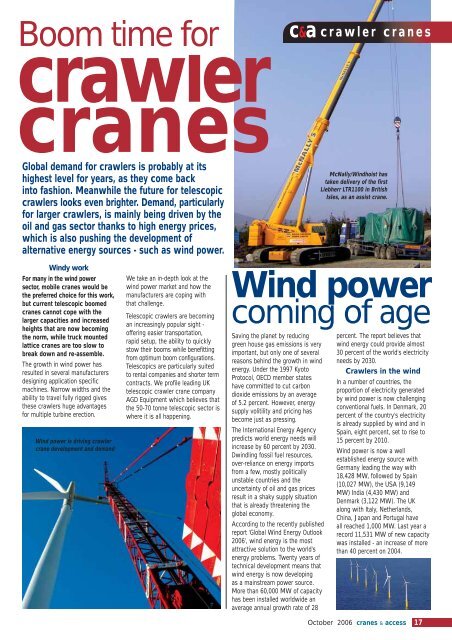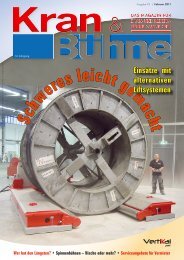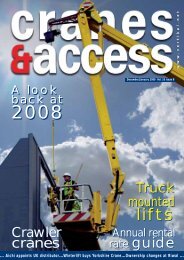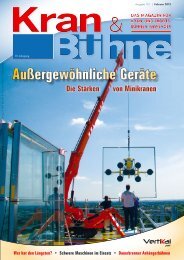You also want an ePaper? Increase the reach of your titles
YUMPU automatically turns print PDFs into web optimized ePapers that Google loves.
Boom time for<br />
crawler<br />
<strong>cranes</strong><br />
Global demand for crawlers is probably at its<br />
highest level for years, as they come back<br />
into fashion. Meanwhile the future for telescopic<br />
crawlers looks even brighter. Demand, particularly<br />
for larger crawlers, is mainly being driven by the<br />
oil and gas sector thanks to high energy prices,<br />
which is also pushing the development of<br />
alternative energy sources - such as wind power.<br />
Windy work<br />
For many in the wind power<br />
sector, mobile <strong>cranes</strong> would be<br />
the preferred choice for this work,<br />
but current telescopic boomed<br />
<strong>cranes</strong> cannot cope with the<br />
larger capacities and increased<br />
heights that are now becoming<br />
the norm, while truck mounted<br />
lattice <strong>cranes</strong> are too slow to<br />
break down and re-assemble.<br />
The growth in wind power has<br />
resulted in several manufacturers<br />
designing application specific<br />
machines. Narrow widths and the<br />
ability to travel fully rigged gives<br />
these crawlers huge advantages<br />
for multiple turbine erection.<br />
Wind power is driving crawler<br />
crane development and demand<br />
We take an in-depth look at the<br />
wind power market and how the<br />
manufacturers are coping with<br />
that challenge.<br />
Telescopic crawlers are becoming<br />
an increasingly popular sight -<br />
offering easier transportation,<br />
rapid setup, the ability to quickly<br />
stow their booms while benefitting<br />
from optimum boom configurations.<br />
Telescopics are particularly suited<br />
to rental companies and shorter term<br />
contracts. We profile leading UK<br />
telescopic crawler crane company<br />
AGD Equipment which believes that<br />
the 50-70 tonne telescopic sector is<br />
where it is all happening.<br />
c&a<br />
Saving the planet by reducing<br />
green house gas emissions is very<br />
important, but only one of several<br />
reasons behind the growth in wind<br />
energy. Under the 1997 Kyoto<br />
Protocol, OECD member states<br />
have committed to cut carbon<br />
dioxide emissions by an average<br />
of 5.2 percent. However, energy<br />
supply volitility and pricing has<br />
become just as pressing.<br />
The International Energy Agency<br />
predicts world energy needs will<br />
increase by 60 percent by 2030.<br />
Dwindling fossil fuel resources,<br />
over-reliance on energy imports<br />
from a few, mostly politically<br />
unstable countries and the<br />
uncertainty of oil and gas prices<br />
result in a shaky supply situation<br />
that is already threatening the<br />
global economy.<br />
According to the recently published<br />
report 'Global Wind Energy Outlook<br />
2006', wind energy is the most<br />
attractive solution to the world's<br />
energy problems. Twenty years of<br />
technical development means that<br />
wind energy is now developing<br />
as a mainstream power source.<br />
More than 60,000 MW of capacity<br />
has been installed worldwide an<br />
average annual growth rate of 28<br />
crawler <strong>cranes</strong><br />
McNally/Windhoist has<br />
taken delivery of the first<br />
Liebherr LTR1100 in British<br />
Isles, as an assist crane.<br />
Wind power<br />
coming of age<br />
percent. The report believes that<br />
wind energy could provide almost<br />
30 percent of the world's electricity<br />
needs by 2030.<br />
<strong>Crawler</strong>s in the wind<br />
In a number of countries, the<br />
proportion of electricity generated<br />
by wind power is now challenging<br />
conventional fuels. In Denmark, 20<br />
percent of the country's electricity<br />
is already supplied by wind and in<br />
Spain, eight percent, set to rise to<br />
15 percent by 2010.<br />
Wind power is now a well<br />
established energy source with<br />
Germany leading the way with<br />
18,428 MW, followed by Spain<br />
(10,027 MW), the USA (9,149<br />
MW) India (4,430 MW) and<br />
Denmark (3,122 MW). The UK<br />
along with Italy, Netherlands,<br />
China, Japan and Portugal have<br />
all reached 1,000 MW. Last year a<br />
record 11,531 MW of new capacity<br />
was installed - an increase of more<br />
than 40 percent on 2004.<br />
October 2006 <strong>cranes</strong> & access<br />
17

















